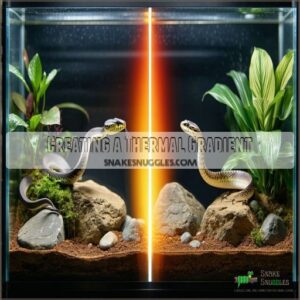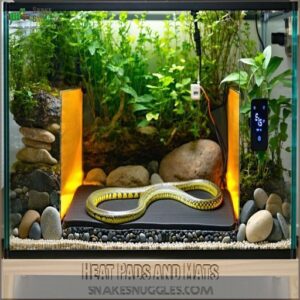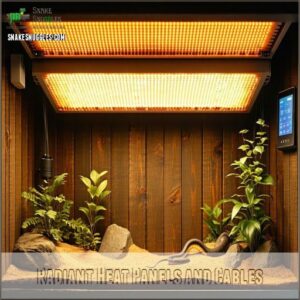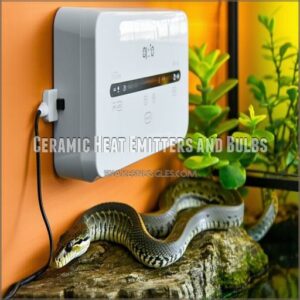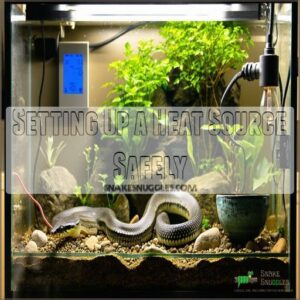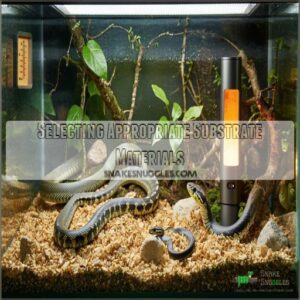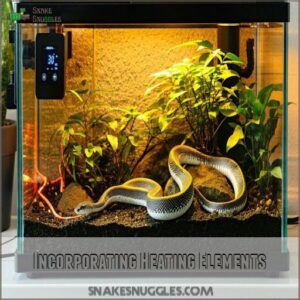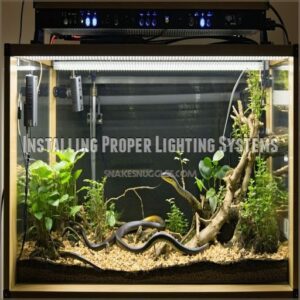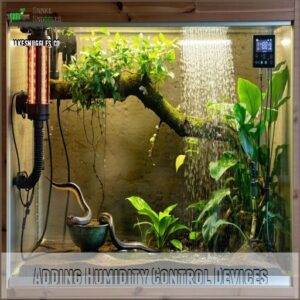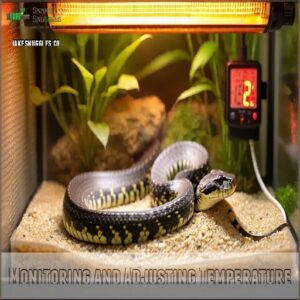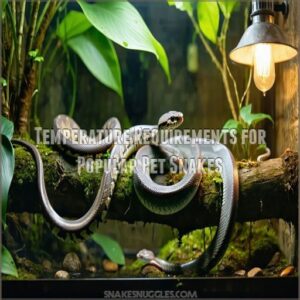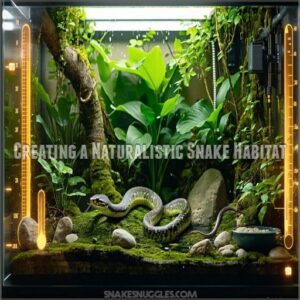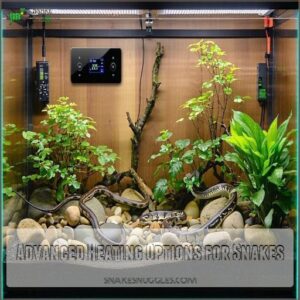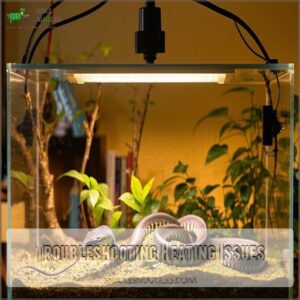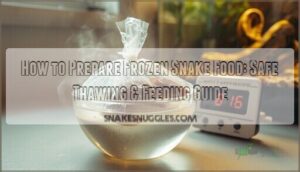This site is supported by our readers. We may earn a commission, at no cost to you, if you purchase through links.
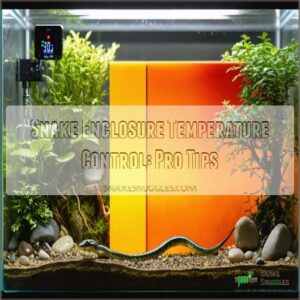 Getting snake enclosure temperature control just right is like fine-tuning a thermostat in your living room—except your guest can’t complain, and the stakes are higher!
Getting snake enclosure temperature control just right is like fine-tuning a thermostat in your living room—except your guest can’t complain, and the stakes are higher!
Start by creating a thermal gradient with a warm side (85°F) and a cool side (75°F). Heat mats or lamps should only cover part of the enclosure, allowing your snake to move between zones for comfort.
Attach a thermostat to keep temperatures consistent and prevent overheating—nobody likes crispy snakes! Use a thermometer on each end for regular checks.
With this setup, your scaly friend will thrive. Curious about specific heat sources or smart controls? Stay tuned!
Table Of Contents
- Key Takeaways
- Creating a Thermal Gradient
- Choosing The Right Heat Source
- Setting Up a Heat Source Safely
- Essential Components for Optimal Snake Enclosures
- Monitoring and Adjusting Temperature
- Temperature Requirements for Popular Pet Snakes
- Creating a Naturalistic Snake Habitat
- Maintaining a Healthy Temperature Range
- Advanced Heating Options for Snakes
- Troubleshooting Heating Issues
- Frequently Asked Questions (FAQs)
- How to control the temperature in a snake’s enclosure?
- How do you heat a snake enclosure?
- How do you protect a snake enclosure from overheating?
- How do you keep a snake warm?
- How do I choose the right heating solution for my snake?
- How do you care for a snake enclosure?
- How to regulate temperature in a snake tank?
- What temperature should a snake enclosure be?
- Where should I put my thermometer in my snake tank?
- How do I keep my snake enclosure warm at night?
- Conclusion
Key Takeaways
- Create a thermal gradient with a warm side (85°F) and a cool side (75°F) to let your snake regulate its body temperature as needed.
- Use heat mats, ceramic emitters, or radiant panels safely, and pair them with a thermostat to prevent overheating or underheating.
- Place thermometers on both ends of the enclosure to monitor the gradient and make adjustments based on your snake’s species-specific needs.
- Insulate the enclosure and use nighttime heating solutions like ceramic emitters to maintain stable temperatures without risking overheating.
Creating a Thermal Gradient
You’ll need to create different temperature zones in your snake’s enclosure, just like their natural habitat has both sunny and shady spots.
With a warm side at 85°F and a cool side at 75°F, you’re giving your scaly friend the perfect setup to regulate their body temperature, which is essential for their health and happiness.
Choosing The Right Temperature Range
Figuring out the right snake enclosure temperature range is key to your snake’s comfort. Aim for a gradient they can explore:
- Cool side: 75-80°F.
- Warm side: 80-85°F.
- Species-specific hot zones help meet unique thermal needs.
- Use accurate tools for temperature research.
- Regular checks guarantee your climate control system stays snake-friendly.
Setting Up a Heat Source
Now that you’ve nailed the ideal temperature range, let’s tackle setting up your heat source. Your heat source options include heat mats, which are great for belly heat, or heat lamps for basking.
Safe installation is key: secure that heat mat under one side of the tank or suspend your heat lamp securely.
A thermostat is your best friend for temperature control, ensuring your snake enclosure temperature control is on point. This precise thermal management prevents overheating or chills.
Maintaining Varied Temperature Zones
Snakes thrive when you create distinct temperature zones in their enclosure.
Use a heat mat or lamp on one side to form a basking spot and leave the other end as a cool zone.
This thermal gradient guarantees proper heat distribution and prevents harmful temperature fluctuation.
Install thermometers in both spots to manage zone management and maintain effective climate control.
Choosing The Right Heat Source
Picking the right heat source for your snake isn’t just about keeping things warm—it’s about ensuring consistent and safe temperatures.
From heat mats to ceramic emitters, each option has its strengths, so knowing your setup and your snake’s needs is key.
Heat Pads and Mats
Heat pads are a solid choice for snake enclosure temperature control. They’re energy-efficient and easy to install, but safety is key.
To create an ideal environment, consider using reptile heat mats that provide a temperature gradient.
- Place heat mats under or on the side, covering 1/3 of the floor.
- Use thermostat control to manage wattage and temperature.
- Verify substrate compatibility to prevent overheating.
- Prioritize safety precautions like protective barriers.
Radiant Heat Panels and Cables
Radiant heat panels are perfect for consistent, even warmth in your snake enclosure.
Mounted overhead, they mimic sun-like heating without the risk of burns.
Pair panels with secure cable management to prevent snake entanglement.
Heat cables, tucked safely under substrate or behind walls, help fine-tune gradients.
For peak performance, consider Radiant Heat systems that cater to specific snake species.
Always check panel installation and cables for safety, ensuring reliable snake enclosure temperature control.
Ceramic Heat Emitters and Bulbs
Ceramic heat emitters are a great tool for reliable, light-free warmth. They’re durable, efficient, and perfect for nighttime setups.
To use them safely:
- Placement: Mount securely to avoid contact with snakes.
- Control: Pair with a thermostat to manage thermal outputs.
- Safety: Add a heat guard to prevent burns and keep your snake cozy.
A solid pick for any snake heating guide!
Setting Up a Heat Source Safely
Setting up a heat source safely is all about preventing accidents while keeping your snake cozy.
You don’t want your curious pet turning a heat bulb into a jungle gym, so secure everything and use a thermostat to keep temperatures just right.
Safe Placement of Heat Elements
Place heat elements like ceramic emitters or panels where snakes can’t directly touch them—think strategic ceiling spots or caged sides.
Heat mat placement works best under one-third of the enclosure floor for a cozy gradient.
Add thermal barriers for burn prevention and avoid clumsy setups. A safe heat source placement keeps safety intact while creating a comfy snake enclosure temperature control system!
Using Thermostats for Temperature Control
A reptile enclosure thermostat is your best friend for heat source management. Proper thermostat calibration guarantees stable temperatures.
Attach temperature probes near warm zones for precise thermal monitoring.
Digital control systems simplify snake enclosure thermostat settings, preventing overheating.
For ideal heating solutions, it’s vital to research and understand the specific needs of your pet snake.
Check your snake enclosure temperature control system regularly for accuracy.
The best snake enclosure thermostat keeps your pet cozy and safe, day and night.
Installing Protective Barriers for Heat Bulbs
Heat bulb guards are a must for snake enclosure safety. They prevent burns to curious snakes and keep you worry-free.
Use barrier materials like metal cages or mesh covers that can handle high heat. Installing the right ceramic heat emitters is essential for effective temperature control.
Install them securely for safe placement. Reptile heat lamps get hot, so prioritize burn prevention and electrical safety to maintain a reliable snake enclosure temperature control system.
Essential Components for Optimal Snake Enclosures
You’ll need to create a comfortable and safe habitat for your snake, which means considering several key components.
These essentials include the right size enclosure, appropriate substrate, heating elements, proper lighting, and humidity control devices.
Choosing The Right Size Terrarium
Think big, but not too big. Snake habitat design principles emphasize room for movement and hiding. Match terrarium dimensions to your snake’s growth projection—at least two-thirds its length.
Height and width considerations matter too, especially for active climbers. A proper snake enclosure size guarantees comfort and controlled snake enclosure temperature.
Understanding snake housing essentials is vital for creating an ideal environment. Smart terrarium setup? It’s all about balance.
Selecting Appropriate Substrate Materials
Your snake’s substrate is more than flooring – it’s their comfort zone. Choose safe, easy-to-clean materials like aspen shavings or coconut husk for great moisture control.
Newspapers work for simplicity, while reptile carpets reduce cleaning headaches. Match substrate selection to your snake’s humidity needs and enclosure temperature.
Avoid overly dry materials that mess up your temperature gradient setup, and opt for materials that provide great moisture control.
Incorporating Heating Elements
Heating your snake’s enclosure starts with the right tools. Whether it’s a snake heating mat or ceramic emitters, each option works differently. Use a reptile enclosure thermostat for precise snake enclosure temperature regulation.
Add insulation materials to hold warmth. For control, pair heat source options like heat cables with thermal mass items. When selecting a heat lamp for your snake, consider its specific heating requirements.
- Snake heat lamp placement matters.
- Ceramic emitters are light-free.
- Use temperature probes for monitoring.
- Combine heating cables for flexibility.
- Test with a quality thermostat regularly.
Installing Proper Lighting Systems
Lighting options like LED tubes and UVB lighting are essential for your snake’s health.
UVB importance comes from helping vitamin D synthesis, while LED benefits include energy efficiency and safety.
Use timers to control photoperiods, mimicking natural day-night cycles.
For ambient lighting, fluorescent tubes work great.
Avoid overheating by placing basking bulbs securely and using sturdy fixtures.
Adding Humidity Control Devices
Keeping humidity levels right can be tricky, but it’s doable. Use humidity sensors and humidistats to check moisture levels.
Add misting systems or fog machines for consistent control. Water bowls placed strategically boost snake enclosure humidity too.
For tropical species, humidifiers help maintain ideal humidity control. Remember, balancing humidity keeps your snake happy and their skin healthy—no more dry scales!
Monitoring and Adjusting Temperature
Keeping your snake’s enclosure at the right temperature isn’t just important—it’s essential for their health and comfort.
Use reliable tools like thermometers to keep an eye on conditions, and don’t hesitate to tweak heat sources as their needs change.
Using Thermometers and Hygrometers
Think of thermometers and hygrometers as your eyes inside the enclosure.
A reptile thermometer helps track the snake’s temperature range, while humidity sensors promote comfort.
Use digital thermometers for accuracy and calibrate regularly with heat mapping techniques.
Place tools at warm and cool spots, monitoring for temperature fluctuations.
Precise temperature monitoring avoids stress—your snake will thank you!
Adjusting Temperature for Different Life Stages
Snakes’ temperature requirements shift with life stages.
Hatchling care demands warmer zones, about 85-90°F, aiding growth.
Juvenile development prefers a balanced snake enclosure temperature range, typically 80-85°F.
Adult maintenance involves stable gradients, suited to species-specific needs.
During breeding cycles, mimic nature by slightly cooling first, then warming.
Understand these temperature interactions to keep your snake comfy and thriving across its growth stages, with proper temperature requirements.
Adjusting for Day and Night Cycles
Balancing day and night cycles in your snake enclosure mimics natural diel patterns and supports their circadian rhythm.
Gradually lower the temperature at night to reflect natural temperature fluctuations, but don’t dip below your species’ safe range.
Nighttime heating, like ceramic heat emitters, guarantees a steady gradient.
Proper cycle management avoids stress and aligns temperature interactions with your snake’s natural behavior.
Temperature Requirements for Popular Pet Snakes
Keeping your snake healthy starts with understanding its specific temperature needs, which can vary based on species.
Whether it’s a corn snake or ball python, providing the right heat range guarantees they stay comfortable and thrive in their enclosure.
Corn Snakes
You’ve got to nail the snake enclosure temperature for corn snakes. Aim for a gradient: 75-80°F on the cool side, 85-90°F in the basking zone.
Use halogen flood bulbs or a heat mat with a thermostat—it’s your best snake enclosure heating guide.
Understanding Corn Snake care is essential for creating an ideal environment.
Stable temperatures keep Corn Snake Behavior healthy. Monitor humidity too; 40-60% works wonders!
Ball Pythons
Ball pythons thrive when their snake enclosure temperature range hits the sweet spot: 80-85°F on the warm side, with a toasty basking zone at 88-92°F.
Keep the cool side around 75°F for proper thermal regulation.
A good thermostat setting prevents overheating. Think of it as giving your python a spa day—relaxing, controlled, and perfect for reptile health.
Tropical and Temperate Snakes
Tropical species need warmth and humidity, while temperate snakes thrive with slightly cooler temperatures.
Keep warm zones between 80-85°F and cooler areas around 75-80°F. Create a balanced snake enclosure temperature gradient using heat mats, and monitor it with reliable thermometers.
Snake habitat design matters—get thermostat settings right to maintain snake behavior patterns and support proper reptile care tips.
Desert Snakes
Desert snake care means nailing the habitat design for these hot climate snakes. Keep a basking area at 90-95°F with a cooler side around 78-82°F. Use ceramic heat emitters. Don’t overlook thermostat settings!
- Heat mats for consistent warmth.
- Timers for reliable day-night cycles.
- Thermometer checks daily.
- Use humidity trays sparingly.
- Keep the temperature gradient perfect.
Creating a Naturalistic Snake Habitat
Creating a naturalistic habitat helps your snake feel at home while staying healthy and stress-free.
By mimicking its natural environment with proper temperatures, humidity, and cozy hiding spots, you’ll keep your pet both happy and comfortable.
Establishing Proper Temperature Gradients
Getting temperature gradients right means giving your snake options.
A proper thermal gradient lets them choose their comfort zone, like switching between cozy slippers and bare feet.
Use a heat mat or panel on one side for warmth and leave the other cool.
This gradient control guarantees thermal balance, prevents temperature fluctuations, and keeps your snake happy and stress-free.
Incorporating Misting Systems
Snake misting systems can boost humidity levels and support your enclosure’s temperature gradient.
Use spray systems or fog machines to align humidity interactions with your snake’s needs.
Mist timing is vital—avoid overdoing it, as excess moisture invites mold.
Stick with clean, dechlorinated water for safety.
A well-regulated misting routine maintains steady humidity level maintenance, keeping your snake happy and healthy.
Using Humidity-Retaining Substrates
Moisture matters when creating a naturalistic snake habitat. The right substrate keeps humidity levels steady and your snake happy.
Great options include:
- Coconut husk for excellent water retention
- Orchid bark for steady moisture control
- Sphagnum moss for boosting substrate moisture
- Cypress mulch to balance durability and humidity interactions
- Reptile-safe soil mixes for natural humidity management
Understanding snake housing humidity is vital for maintaining ideal conditions.
Always guarantee substrate safety for your snake’s wellbeing.
Maintaining a Healthy Temperature Range
Keeping your snake’s enclosure in the proper temperature range isn’t just important—it’s essential for their health and comfort.
Too much heat can make them stressed, while too little can affect their digestion and overall well-being.
Avoiding Overheating and Underheating
Keeping your snake’s enclosure comfortable isn’t tricky if you monitor carefully.
Overheating risks include snake stress or even thermal shock, so always use heat monitoring systems.
If the enclosure temperature’s too low, underheating signs like lethargy appear.
Aim for steady temperature control to avoid fluctuations.
| Issue | Cause | Effect | Solution | Tools Needed |
|---|---|---|---|---|
| Overheating | Heat source too powerful | Snake stress | Use thermostats | Heat Safety Tips |
| Underheating | Faulty equipment | Lethargy | Replace heat source | Thermometers |
| Temperature too high | No thermostat | Thermal shock | Install heat control systems | Thermostats |
| Temperature too low | Inconsistent monitoring | Cold stress | Maintain regular checks | Hygrometers |
| Fluctuations | Poor enclosure setup | Respiratory issues | Stabilize heat gradients | Heat Monitoring Systems |
Humidity and Temperature Interactions
When heat balance is off, moisture levels spike or plummet, creating thermal swings in air quality. A stable snake enclosure temperature gradient helps avoid these issues.
Use these tips for better climate control:
- Monitor humidity impact with a hygrometer.
- Provide fresh airflow to combat mold.
- Adjust heaters or misters during snake enclosure temperature fluctuations or seasonal temperature adjustments.
Adjusting Temperature for Breeding and Hibernation
Nail breeding cycles and hibernation modes with smart seasonal temperature adjustments.
Gradually drop the snake enclosure temperature range by 5-10°F during cooler months for hibernation, mimicking natural thermal fluctuations.
For breeding, slowly raise the snake enclosure temperature gradient back to warmer levels. Use thermostats to guarantee precision and cater to species-specific needs.
Accurate shifts keep your snake healthy and thriving!
Advanced Heating Options for Snakes
If you’re ready to take your snake’s habitat to the next level, advanced heating options can make care easier and more precise.
From smart thermostats to automated controls, these tools guarantee your snake stays comfy, even if you forget to adjust the dial.
Smart Thermostats and Heating Systems
Temperature control is a delicate balance, and smart thermostats are a game-changer.
These devices offer precise temperature sensors and automated controls, ensuring a comfy environment for your slithery friend.
With separate day and night settings, you can mimic a snake’s natural habitat.
Plus, energy efficiency means lower bills and a greener setup.
Look for features like auto-shutoff and temperature alarms for added peace of mind.
Automated Temperature and Humidity Control
Smart systems with auto regulators and sensor technology make climate control a breeze.
Digital thermostats in automated temperature control systems adjust settings for perfect thermostat calibration. They maintain a cozy thermal gradient without constant monitoring.
These temperature control systems are lifesavers, especially for busy keepers, ensuring your snake stays comfy. Think of it as cruise control for your reptile’s habitat!
High-End Heating Options for Snakes
Looking to upgrade your reptile heating systems?
Deep heat projectors and neodymium heat lamps are game changers, offering precise temperature and gradient control.
Combine them with thermostat automation or biometric monitoring for seamless, automated temperature control.
Radiant panels are ecofriendly heating options that guarantee steady warmth.
These high-end solutions give you peace of mind while keeping your snake cozy and thriving.
Troubleshooting Heating Issues
When your snake’s enclosure isn’t heating properly, it can lead to stress, health issues, or even a very grumpy reptile.
Let’s look at common heating problems and practical fixes to keep your scaly friend comfortable and thriving.
Common Heating Problems and Solutions
When heating issues strike, your snake’s comfort is at risk.
Common snake enclosure temperature problems include uneven gradients or overheating.
Fix them with these tips:
- Reposition heat mats to fix thermal imbalance.
- Calibrate thermostats to prevent overheating.
- Improve insulation if temperatures fluctuate.
- Make certain heating element safety with guards.
- Adjust heat sources seasonally for changes.
Stay alert for these pitfalls!
Identifying Signs of Inadequate Heating
Spotting signs of inadequate heating keeps your snake healthy.
A sluggish snake might be in Cold Stupor, while unusual hiding or refusal to eat points to temperature issues.
Watch for dry, flaky skin—it could mean Thermal Shock.
Here’s a quick breakdown:
| Behavior | Cause |
|---|---|
| Sluggishness | Cold Stupor |
| Hiding often | Heat Stress |
| Refuses food | Temp too low |
| Flaky skin | Thermal Shock |
| Health Issues | Varied Heating |
This information helps you identify potential temperature issues and take corrective action to maintain your snake’s health.
Adjusting Heating Systems for Optimal Performance
If your snake’s basking spot feels off or the enclosure shows temperature fluctuation, tweak your snake enclosure thermostat settings to keep things steady.
Heat source calibration guarantees thermal efficiency without overloading systems. Regular heating system maintenance, like cleaning ceramic emitters or inspecting wiring, prevents hiccups.
Don’t skip snake enclosure temperature monitoring—it’s the secret to performance optimization and a cozy snake home.
Frequently Asked Questions (FAQs)
How to control the temperature in a snake’s enclosure?
Did you know snakes rely on precise temperatures for survival?
Use heat mats, ceramic emitters, or radiant panels to create a gradient.
Pair thermostats and thermometers for balance, letting your snake chill or bask as needed.
How do you heat a snake enclosure?
Heat your snake’s enclosure with tools like heat pads, ceramic heat emitters, or radiant heat panels.
Place the heat source safely, use a thermostat for control, and create a temperature gradient for proper thermoregulation.
How do you protect a snake enclosure from overheating?
Place a thermostat on your heat source to regulate temperature and prevent overheating.
Use thermometers to monitor regularly.
Add good ventilation and never run heat lamps or emitters without checking for safe, consistent settings.
How do you keep a snake warm?
Think of your snake’s enclosure like a cozy home.
Use a heat mat, radiant panel, or ceramic emitter for warmth.
Always pair with a thermostat to prevent overheating and create the perfect temperature gradient.
How do I choose the right heating solution for my snake?
Pick a heat mat, ceramic heat emitter, or radiant panel depending on your snake’s needs and enclosure size.
Use a thermostat for safety, protect heat bulbs, and make certain of ventilation.
Tailor the setup to your species.
How do you care for a snake enclosure?
Caring for a snake enclosure is like crafting the perfect mini-ecosystem.
Balance a thermal gradient, manage humidity, select safe substrates, and use timers for lighting.
Be vigilant with regular checks to guarantee comfort and safety.
How to regulate temperature in a snake tank?
Place a heat pad or ceramic heat emitter on one side of the tank to create a gradient.
Use thermostats and digital thermometers to monitor levels, ensuring your snake can switch between warm and cool spots easily.
What temperature should a snake enclosure be?
Aim for a warm side between 80-85°F and a cool side at 75-80°F.
Monitor with thermometers and adjust for your snake’s species.
For ball pythons, add a basking spot around 88-92°F.
Where should I put my thermometer in my snake tank?
Stick one thermometer on the warm side near the heat source and another on the cool side.
This gives you a clear picture of your snake’s thermal gradient, making adjustments smoother and safer for them.
How do I keep my snake enclosure warm at night?
Use a ceramic heat emitter or a heat pad paired with a thermostat to keep temperatures stable overnight.
Insulate the enclosure with foam panels or blankets (not covering vents) to maintain warmth efficiently.
Conclusion
Dialing in snake enclosure temperature control might feel tricky at first, but it’s not rocket science once you break it down.
By creating a proper thermal gradient, choosing safe and effective heat sources, and monitoring temps with reliable tools, you’re setting your snake up for a comfy, stress-free environment.
Remember, your snake relies on you for this balance—so stay consistent, keep learning, and adjust as needed, to create a stress-free environment and ensure a happy snake means you’re doing it right!
- https://mysnakepet.com/snake-heating-pads/
- https://snakesnuggles.com/snake-enclosure-heating-recommendations/
- https://www.reptiles.swelluk.com/help-guides/how-to-select-the-right-heating-system-for-your-reptile/
- https://www.thebiodude.com/collections/reptile-thermostats-thermometers
- https://cyfairanimalhospital.com/snakes/snake-owning-101-heat-humidity-habitat/

